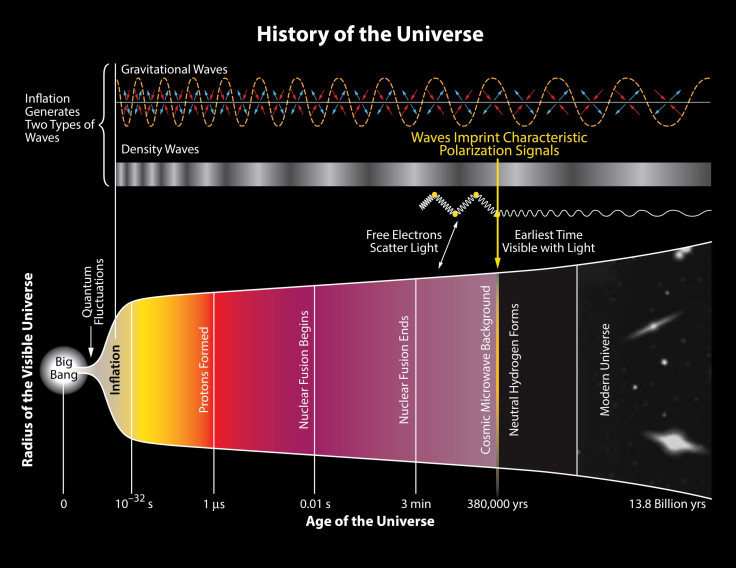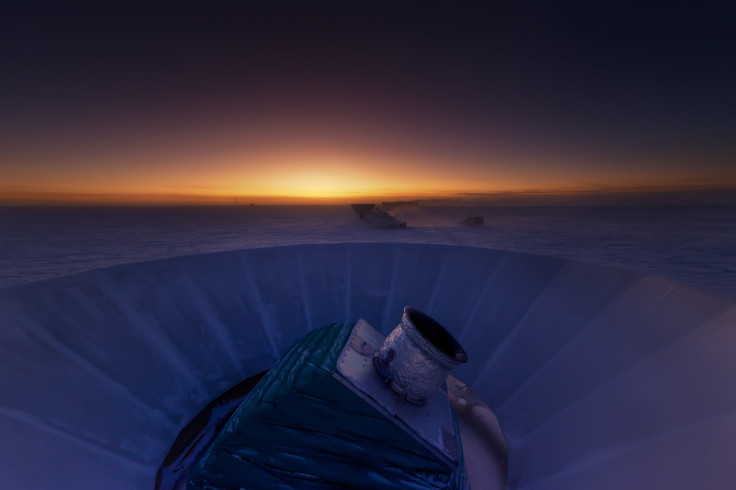What Are Gravitational Waves? The Big Discovery That Has Everyone Talking Is Evidence Of Cosmic Inflation
Scientists at the Harvard-Smithsonian Center for Astrophysics said they had big news to share this week, and they did not disappoint: The researchers said at a press conference on Monday that they found evidence for cosmic inflation and primordial gravitational waves.

Researchers from the CfA, the University of Minnesota, the California Institute of Technology and Stanford University contributed to the discovery. Rumors ahead of the announcement that predicted the researchers had used the BICEP2 telescope, located at the National Science Foundation’s South Pole Station, to find evidence of gravitational waves in the cosmic microwave background (CMB), or the “afterglow of the Big Bang,” as a University of Minnesota press release put it, proved true.
The theory posits that immediately after the Big Bang, which occurred around 13.8 billion years ago, the inflation epoch began, when everything from particles to gravitational waves, or “ripples in space-time,” were sent outward. All of this happened in the span of 10 to 32 seconds, scientists from the University of Minnesota noted. This is the first evidence that scientists have discovered that proves the existence of gravitational waves, and it provides the first measurable evidence that the exponential expansion of the universe is real, and not just theoretical. Before Monday, it had not yet been proved. Albert Einstein predicted the existence of gravitational waves in his General Theory of Relativity, and it was the last part of his theory that had yet to be proved.

Clem Pryke, from the University of Minnesota, said in a statement, “It’s the smoking gun for inflation.” Pryke said the only explanation for the primordial gravitational wave evidence from BICEP2 was "cosmic inflation."
The researchers were looking for a specific signature in the CMB, a “twisting” pattern, known as a B-mode polarization. The signature was much stronger than the team expected, and they likened it more to a “crowbar” than a “needle” in a haystack. The team spent three years observing the BICEP2 data, ruling out dust and other factors that could explain the twisting patterns in the CMB.
Avi Loeb, from Harvard, said in a statement, “This work offers new insights into some of our most basic questions: Why do we exist? How did the universe begin? These results are not only a smoking gun for inflation, they also tell us when inflation took place and how powerful the process was.” The evidence of the primordial gravitational waves provides researchers with the earliest look at the universe.
Prior to cosmic inflation, the universe was incredibly small and controlled by a unified singular force that was later split into four spate forces: electromagnetic, strong nuclear, weak nuclear and gravitational forces, known as the Planck epoch. Pryke said, “The discovery has implications for those trying to formulate [a unified theory that describes all the forces].”
The BICEP project began at Caltech in 2002, and the team built the BICEP2 telescope from scratch to find evidence of gravitational waves. “The circuit board included an antenna to focus and filter polarized light, a micro-machined detector that turns the radiation into heat, and a superconducting thermometer to measure this heat," Jamie Bock said in a statement,

Alan Guth, now at MIT, first theorized the existence of cosmic inflation in 1980 and was thrilled to hear that evidence had been discovered that confirmed his theory. Speaking to the New York Times, Guth said he was “bowled over” when he heard the news.
The researchers said the recent discovery of evidence proving the existence of primordial gravitational waves and cosmic inflation is just the beginning. They say they will continue to analyze the BICEP2 data. As part of the announcement, the team released the BICEP2 2014 results, complete with facts, figures and papers detailing the work of the researchers.
© Copyright IBTimes 2024. All rights reserved.






















